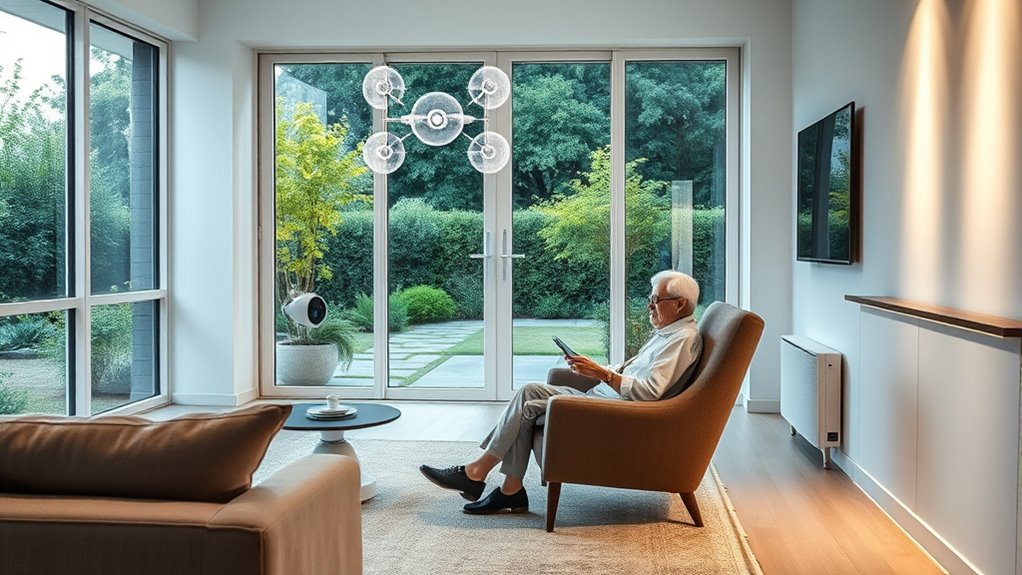The future of age-friendly homes is shaped by smart sensors and automation that keep you safer and more independent. These devices monitor potential hazards like smoke, leaks, or movement, and send alerts instantly to your devices or caregivers. Emergency systems with wearable help buttons add another layer of security. As technology advances, your home will adapt to your routines, making safety seamless and personalized. Keep exploring to discover how these innovations can support your daily life.
Key Takeaways
- Smart sensors provide real-time hazard detection and instant alerts, enhancing safety in age-friendly homes.
- Automated emergency systems ensure rapid response and continuous support, even if users cannot manually seek help.
- User-friendly, customizable safety technologies adapt to individual needs, reducing risks and promoting independence.
- Integration of sensors and devices creates seamless safety networks that respond automatically to emergencies.
- Future advancements will enable smarter, predictive systems that learn habits, increasing security and confidence for older adults.

Technology has revolutionized safety measures across various industries, making it easier to prevent accidents and respond swiftly when incidents occur. In age‑friendly homes, this transformation is especially significant, empowering you to maintain independence while staying protected. One of the most impactful advances is the integration of smart sensors throughout your living space. These sensors continuously monitor environments for signs of danger, such as smoke, carbon monoxide, water leaks, or unusual movement. When a problem is detected, smart sensors instantly send alerts to your smartphone or connected devices, giving you real-time awareness and allowing you to act quickly. This proactive approach minimizes risks and helps prevent emergencies before they escalate. smart sensors are a key element of this technology, providing a comprehensive safety network that adapts to your lifestyle.
Smart sensors in your home detect dangers early, sending instant alerts to keep you safe and independent.
Emergency alerts are another cornerstone of modern safety technology. With these systems in place, you don’t have to worry about missing important notifications during a crisis. When a sensor detects a hazardous condition, an emergency alert is triggered, notifying you and any designated caregivers immediately. This instant communication streamlines the response process, whether it’s calling emergency services, alerting family members, or activating automated safety measures. Many emergency alert systems also include wearable devices or pendants, so you can summon help at the press of a button, even if you’re unable to reach a phone. This ensures that help is always within reach, providing peace of mind for both you and your loved ones.
Furthermore, these technologies are designed to be user-friendly, often customizable to fit your specific needs. For example, smart sensors can be set up to detect falls or sudden health changes, alerting your caregivers without delay. This level of automation reduces the reliance on manual checks and minimizes the risk of overlooked incidents. You also benefit from integration with other smart home devices, creating a thorough safety network that adapts to your lifestyle. The seamless communication between sensors, alerts, and your devices helps to create a home environment that’s not only safer but also more responsive to your daily routines.
As technology continues to advance, the future of age‑friendly homes will see even smarter systems that learn your habits and predict potential hazards, further enhancing safety. You’ll find yourself more confident in your independence, knowing that innovative safety features are working tirelessly to protect you. In this way, smart sensors and emergency alerts aren’t just tech buzzwords—they’re essential tools that help you enjoy your home with greater security and peace of mind.
Frequently Asked Questions
How Affordable Are Age-Friendly Home Technologies for Seniors?
You might wonder how affordable age-friendly home technologies are for seniors. A thorough cost analysis shows prices vary widely, but many options are becoming more accessible. Technology accessibility improves as devices become simpler to use and more affordable. While some advanced systems still carry high costs, basic safety and convenience tools are increasingly budget-friendly, making it easier for seniors to upgrade their homes without breaking the bank.
Are There Privacy Concerns With Monitoring Devices in Homes?
You might worry about privacy concerns with monitoring devices in homes. Data security is vital, so make certain your devices have strong protections. Consent challenges can arise if you’re not fully informed or comfortable with monitoring, so it’s important that you understand what data is collected and how it’s used. Being aware of these issues helps you make better choices, keeping your privacy safe while using helpful safety technologies.
What Training Is Needed for Seniors to Operate New Technologies?
You need proper training to operate new technologies effectively. Virtual tutorials help you learn at your own pace, while hands-on workshops give you practical experience. These methods guarantee you understand how to use devices confidently and safely. By participating in these training options, you stay independent and comfortable with technology, reducing frustration and enabling you to benefit from age-friendly innovations in your home.
How Reliable Are Emergency Response Systems Integrated Into Smart Homes?
Imagine a lifeline that never fails—emergency response systems in smart homes are designed to be highly dependable. With emergency accuracy as a priority, these systems use advanced sensors and alerts to detect issues quickly. System redundancy ensures there’s always a backup, so help arrives even if one part fails. While no system is perfect, when well-maintained, they offer peace of mind, knowing you’re truly protected.
Can These Technologies Be Customized for Individual Health Needs?
You can definitely customize emergency response systems for your specific health needs. Adaptive technology allows these systems to provide personalized health support, ensuring alerts and responses are tailored to your condition. By integrating sensors and monitoring devices, your smart home can recognize changes in your health, offering proactive assistance. This customization improves safety and peace of mind, making your home truly age-friendly and responsive to your unique requirements.
Conclusion
By embracing technology and safety, you create a home that protects, empowers, and comforts. You build a space where independence is preserved, risks are minimized, and peace of mind is gained. You craft an environment that adapts, evolves, and supports your every step. With each innovation, you turn your house into a sanctuary. In this future, safety and technology work together, guiding you safely, confidently, and comfortably through every day.








